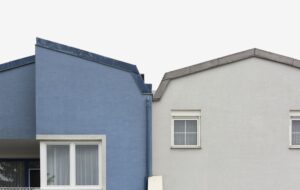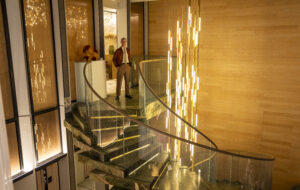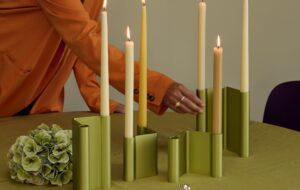
words Alex Wiltshire
Tord Boontje talks in the most quiet and earnest of tones, but he’s clearly delighted at the success of his Happy Ever After installation at Milan this year.
He filled a showroom with a series of textile-festooned furniture for Italian furniture company Moroso. “We used textiles very much how they are used in fashion, which I’m really interested in anyway,” he says, wide eyes emphatically emphasising points. “That sensuality in fashion I wanted to bring into this furniture.” Set in four areas, the pieces included the Princess chair, which features voluminous bunches of silk and embroidery with interlaced crystals.
The Princess chair, along with all Boontje’s other designs, originated from the end of an alleyway off Peckham High Street in South-east London. But it’s not until you go through the tiny yard and up the stairs into his cramped studio that the hippy baroque exuberance really hits you. Every square centimetre of wall space is covered in sketches, printouts, material samples and prototypes, with colourful garlands hanging from the ceiling. Sitting at a long table against one wall are two designers painstakingly drawing out sinuous new designs on their Macs, and the studio manager, who is taking calls from journalists from all over the world asking for interviews.
Boontje, born in 1968 in the Netherlands, studied at Design Academy Eindhoven and went on to do the Industrial Design course at the Royal College of Art, graduating in 1994. There’s a sense of the “typical” Dutch conceptual design in his early work, such as with his simple and austere Rough and Ready project, but his signature style dramatically evolved in 2001 with the launch of the Wednesday Collection. The range of light shades, chairs, and tables, a cabinet and glassware, characterised by an organic and romantic naturalism, used a variety of production techniques, from embroidery to laser etching.
He points towards the Babylon chair for the Moroso show, which is draped with a synthetic suede called Alcantara. “You can laser-cut it really well, and it’s really strong,” says Boontje, handing over a bunch. “You can work really fine with it. I really like it because it’s something you can’t possibly make by hand. Only with a machine can you make this, I think that’s pretty amazing.”
The highly detailed and intricate patterns that Boontje works into much of his designs, such as the photographically etched-steel Wednesday Light, can only be achieved with modern technology and materials, often manufactured directly from digital files. He is fascinated by the potential of recent changes in manufacturing technology, but for him, technology is only a means to an end. His interest in craft, such as embroidery, remains a strong inspiration.
“When I look at it I think it’s really amazing and think we’ve really lost something. Everything made now is so neutral and plain. There’s something really amazing there that we can translate to our time. But this isn’t about being nostalgic. I think it’s very important to work as progressively as possible.” He hands over a piece of silk made for the Moroso installation that started out as a watercolour painting. The pattern is repeated, so it looks a bit like a Rorschach test. “I like to use this very accurate digital printing to make organic things. Because of the mirroring you’re making something that you could never do in nature, but on computer you can do it.”
But Boontje believes that technology cannot replace the vital initial stages of realising an idea. When he first began exploring what eventually became the Wednesday Light it took two days for two people to laboriously cut out the shapes in paper by scalpel. “It was a huge labour and many designers shy away from going through that whole struggle, but by really doing it you start to really understand the material.” And this use of technology is not just a matter of convenience: “If I wanted to make the most convenient things I wouldn’t do these sort of things,” he says with a laugh.
Most designs are worked out on paper first, before being drawn on computer. Is he a good draughtsman? “Well, trying to be. No, pushing … yeah, no, I can draw. I thought I couldn’t but when I realised it was really necessary for this kind of work you draw more and more.” He is using watercolours for a range of ceramic tiles for Bardelli, and is excited with the effects that new printing processes can reproduce. He picks up a rough painting: “I can print exactly like this, with the gradations of the watercolours – it’s quite a recent thing that they can print like that.”
The other key benefit of modern digital production methods is that they enable cheap mass production, which is a major concern of Boontje’s. He designs objects that are intended to be lived with. “I think if they are priced at the top of the market then they would lose that idea,” he says. “Only by making them really available can you achieve that idea of making.” Such thinking is consistent with his incredibly successful Garland lightshade for Habitat, a cheaper version of the Wednesday Light that retails at £15 (and brings little in the way of royalties).
The practical origins of this thinking lie in a project he started just after leaving the RCA. Rough and Ready was a personal reaction to slickly designed expensive furniture. “I started to get really annoyed with the sort of stuff designers were making and I thought, ‘That’s not how I live, that’s not how I want to live’.” Rough and Ready is a utilitarian range of furniture made from easy-to-find and recycled materials, and Boontje released the plans free of charge so that people could make it for themselves. “It wasn’t viable “It wasn’t viable as a commercial project unless you changed it so much that there wouldn’t be any point any more,” he says. “It would be an expensive chair. So by giving away the drawings it was a new way of getting around that problem.” This open source approach has led to Boontje sending off 33,000 to date. While he says he doesn’t ask for people to send him pictures of their results (“I think it’s best just to let go”), the pride he has in how the project has progressed is evident. “Each chair is different and personal, and if it breaks you know how to fix it. It goes against so many things that we take for granted in a consumer society.” He also looked at consumer attitudes in transGlass, a company he formed in 1997 with his partner Emma Woffenden, a glass artist who shares his studio. The project creates beautifully cut glassware from recycled wine and beer bottles – radically transforming them from waste to luxury products.
In 2000 Boontje and Woffenden gave birth to their daughter, Evelyn, a period that Boontje directly attributes to the inspiration behind the new style he developed with the Wednesday Collection. “I think I started to think much more – when you get a child you go through this kind of nesting instinct, something very basic, very human,” he says. “It really makes you aware of what you want your home to be like and I realised that my idea of home is not like a box or a cube that you live in, it’s something completely different, it’s warmer, more organic, and full of nature, casualness and pleasant.” After Evelyn was born he had little work going on, but at the end of 2000 he was given a commission by the British Council to do an installation at their Prague offices. Already the beginnings of a new direction were developing and he had to warn the British Council that the show might be very different to what they might be expecting. But they were OK with it. It was a bit of a leap of faith for Boontje as well: “At that point I was so trained to avoid decoration – you didn’t really embrace it, to try to translate it into something forward looking was a big step for me. It also seemed really mad to be doing that kind of work but I really enjoyed it and I thought that at least I’d have a nice exhibition in Prague with it. I wanted to just see where it went. I had no idea where it would go.”
Four years later, Boontje has finally managed to rid himself of the uncertainty of where the next commission is going to come from. When he does experience a dry patch, the transGlass project is enough to keep him occupied. “It was an important thing to realise – transGlass meant that I didn’t need anyone else, that I could do my own thing and that I don’t need to wait until a client comes along,” he says.
Boontje looks to Ron Arad as a great example of a designer who has his own agenda, and such single-minded focus is apparent in Boontje as well. His path so far has been remarkably consistent in concept (if not form) and appears to be more a reaction to issues he felt important than to market forces. While his flowery opulence has almost come to symbolise current aesthetic trends, its conceptual basis and clever melding of traditional crafts and modern technology will hopefully mean that his success won’t just be flash in the pan.
What about the future? “No doubt the work is changing now anyway to what it was four years ago. There are new elements coming in, new emotions,” he says, referring to a new interest in using black, like with his Come Rain or Shine chandelier for the Selfridges Brasil 40° event. “Scarier sides! Things are always evolving and changing. But this direction feels really good and I’m excited with it.” Still happy? “Yeah!”
















